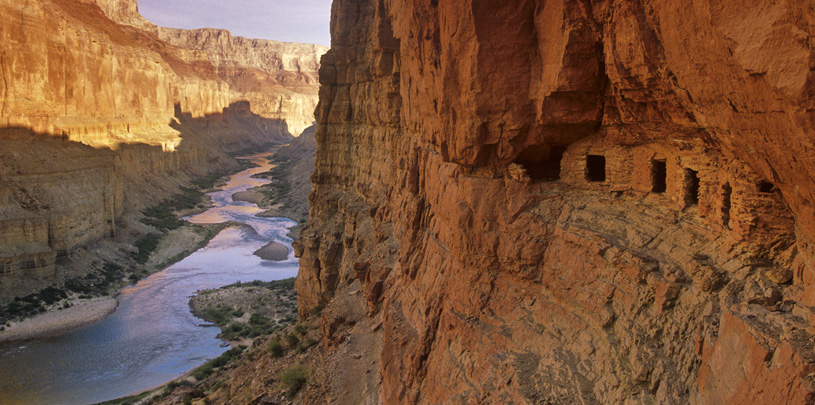
 by Roger Clark, Grand Canyon Director
by Roger Clark, Grand Canyon Director
Being named America’s Most Endangered River is a dubious honor. First place in rivers under siege is the last place we want the mighty waters that cut Grand Canyon to be. So when American Rivers asked Grand Canyon Trust to be its local partner in designating Grand Canyon’s reach of the Colorado River the Most Endangered River in America, we jumped at the chance to spotlight the clear and present dangers to the canyon’s precious waters and what we’re doing to stop them.
Among the most serious threats to Grand Canyon’s waterways are uranium mines and commercial developments.
Uranium mining started along Grand Canyon tributaries in the 1950s. Dozens of mines were opened and closed within the Kanab Creek watershed, and seepage from Orphan Mine on the South Rim has been polluting Horn Creek for more than two decades.The National Park Service advises hikers not to drink even filtered water from these two creeks and several others where harmful levels of radionuclides are being measured.
In 2010, water samples taken by the U.S. Geological Survey identified more contaminated sites “related to mining processes.” They found 15 springs and five wells that contained dissolved uranium concentrations in excess of the Environmental Protection Agency's standards for safe drinking water.
In 2012, the Secretary of the Interior issued a 20-year ban on new uranium claims on one-million acres of public lands adjacent to Grand Canyon National Park. His decision was the direct result of a multi-year campaign by Havasupai leaders, conservationists, and a coalition including water districts, ranchers, Arizona’s state wildlife agency, sportsmen, business leaders, and elected officials.
However, four preexisting uranium mines continue to pollute water within the withdrawal area. Records show, for example, that highly contaminated groundwater (80 times the limit set to protect public health and the environment) is being pumped from Pinenut uranium mine immediately north of Grand Canyon National Park. The Grand Canyon Trust and allies are pressuring agencies to require aquifer monitoring and other compliance measures to reduce risks of pollution from uranium mines that continue to operate.
In 2010, Scottsdale developers unveiled plans to build a billion dollar tourist resort on the east rim of the Grand Canyon, with a tramway to carry up to 10,000 visitors a day down to the confluence where the Colorado and Little Colorado rivers meet. The “Grand Canyon Escalade” and its associated access road and infrastructure would be built on land controlled by the Navajo Nation. Dozens of Navajo citizens who hold grazing leases within the proposed resort’s 420 acres footprint oppose the project. In 2012, this core group invited Grand Canyon Trust to become part of its Save the Confluence coalition and to join their fight to stop Escalade.
Ten thousand tram-riders a day will demand a highly effective sewage system. In addition to a 4,000 sq. ft. “restroom facility,” Escalade promoters plan to build food and beverage, retail, and other structures at the bottom of the Grand Canyon, just upriver from the Colorado’s confluence with the Little Colorado River. And yet Escalade’s proposed “master agreement” with the Navajo Nation does not include any sewage treatment facilities down by the rivers that host the last breeding area for the endangered humpback chub.
Escalade investors have spent several million dollars to convince the Navajo Nation’s president and 24-member council to approve the secretly negotiated master agreement and developer-written legislation. With support from the Navajo president, promoters predicted full approval by the Navajo Council by the end of 2014. But, due to strong opposition by local Navajo residents and the Save the Confluence coalition, they have failed to find a single sponsor to introduce supporting legislation.
While approval of Escalade is working its way through the Navajo legislative process, Save the Confluence is prepared to block any final approval. More than 30 families intend to file an injunction against the bill’s land transfer without their permission, as required under Navajo law. Hopi leaders, who voted unanimously against Escalade when it was first proposed, are poised to enforce an inter-tribal compact which prohibits development at the confluence without consent of both tribes. And the National Park Service stands ready to challenge the tram’s intrusion into its jurisdiction.
Grand Canyon Trust is pleased to join American Rivers in calling upon all citizens to fight against assaults on Grand Canyon’s sacred waters. The Most Endangered River announcement is a timely reminder that the entire Grand Canyon needs our enduring support to protect.
80% of Arizona voters support Baaj Nwaavjo I'tah Kukveni National Monument, according to a new poll.
Read MoreThe Colorado River below Glen Canyon Dam is heating up. Find out why.
Read MoreGroundwater pumping at a uranium mine near the Grand Canyon will affect the canyon's springs, scientists says.
Read More